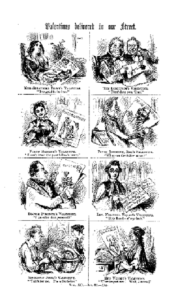Two of the most popular forms of 19th century entertainment were reading novels and attending the theater, so it is no surprise that best-selling novels were often adapted to stage plays. In an earlier post on domestic dramas, I mentioned the theater’s bad reputation in the early 19th century, but the stigma attached to the playhouse dissipated over time. Theater attendance gradually became more socially acceptable and even fashionable among the middle class by the 1840s and ’50s, partly due to theater managers and playwrights’s deliberate efforts to appeal to middle class values and moral standards, and partly due to the Victorian era reverence for Shakespeare, which resulted in higher regard for the theater. By the 1850s, theaters were central to the developing culture of American cities.
Harriet Beecher Stowe’s Uncle Tom’s Cabin was one of the best-selling novels of the century and spawned many stage adaptations. As popular as the novel was, many Americans were first exposed to the story at the playhouse. Copyright laws did not prevent dramatizations of novels and other printed fiction, so the first stage production of Uncle Tom’s Cabin actually debuted before the final installation of the novel was published. Uncle Tom’s Cabin is remembered as an important text in turning northern sentiments more toward abolitionism, and one would expect that the theatrical productions would have served the same purpose, moving audiences to oppose slavery as immoral and inhuman. However, the dramatizations differed significantly from each other and from the original novel, often resulting in completely divergent political messages and tones. Some productions made their own additions to “finish the story”; manager G.C. Howard and actor George Aiken’s 6-act production ended with Uncle Tom’s death and ascension to heaven (Frick). Other adaptations changed the tone of Stowe’s text, undermined Stowe’s overtly abolitionist politics to promote compromise between the North and South, and, worst of all, some of the most popular adaptations reinforced racial stereotypes and the dehumanization of slaves.
Uncle Tom’s Cabin is notable as an instigating force in tensions between the North and South over slavery; Abraham Lincoln referred to Stowe as the “little woman who started this war.” Stowe’s story moved some sympathetic viewers and readers to support the abolitionist movement and view slavery as an immoral instution. However, the theatrical productions were deeply problematic with regard to representing race on the stage. It was relatively easy for white readers to sympathize with the Black characters; Stowe heavily emphasized the morality of Eliza and Tom as humans and Christians in spite of their race, and there is the fact of Eliza’s light skin and her ability to “pass” as white. Scholarship on the problems of racial stereotypes and representation in Stowe’s novel is extensive, so I will not analyze that here. On the stage, audiences were confronted with the characters’ physicality in a more direct way, and many productions fell back on the established stereotypes of Black characters. This was especially true of the “Tom Show” adaptations of Uncle Tom’s Cabin, short comedic pieces that were loosely based on the novel, but which often resembled blackface minstrels. For example, C.W. Taylor’s production was presented as an afterpiece, so he cut several key episodes, two major characters, and added several musical numbers; the result was a play mocking the South and side-stepping many of the controversial and overtly abolitionist material in Stowe’s novel. Other Tom Shows were sensationalized melodramas that greatly expanded the roles of white characters and eliminated secondary Black characters like Topsy. Tom Shows often reduced the characters to racist caricatures and often turned the text into slapstick comedy. Unfortunately, the Tom Shows were exceedingly popular throughout the 19th century and into the early 20th century (with most references to slavery erased from the text after the Civil War), and perpetuated the racist genre of the minstrel show.
Even among the dramatizations that stayed close to the original novel’s text, racial representation on stage was still a problem. Nineteenth century productions typically had all-white casts, so there is the significant issue of the erasure of Black characters by virtue of their representation by white actors. As mentioned earlier, Eliza’s race is ambiguous, and Stowe emphasizes the lightness of her skin, the fact that she didn’t “look like a slave,” so one may expect a white actress to fill this role. However, Tom and his family are clearly described with dark skin, a fact that no production could avoid. Although the theater often attracted individuals from more marginalized sectors of society, including immigrants from southern and eastern Europe and individuals with Gypsy and Jewish heritage, the vast majority of actors in major theaters were white. Resultantly, actors used make-up to play characters of different races. Acting manuals from the era include detailed instructions for playing characters of different races, especially Native Americans and African Americans, because these were popular stock characters in American plays. These instructions are rife with racial stereotypes that were typical in dehumanizing minstrel shows, and likely informed the way actors played the minor characters in Uncle Tom’s Cabin, even in the more faithful adaptations of Stowe’s text. The audience expected particular portrayals of minority characters and theater managers and star actors were all too willing to cater to those expectations.
Works Cited
Frick, John. “Uncle Tom’s Cabin on the Antebellum Stage.” http://utc.iath.virginia.edu/interpret/exhibits/frick/frick.html
http://www.harrietbeecherstowecenter.org/utc/american_culture.shtml
